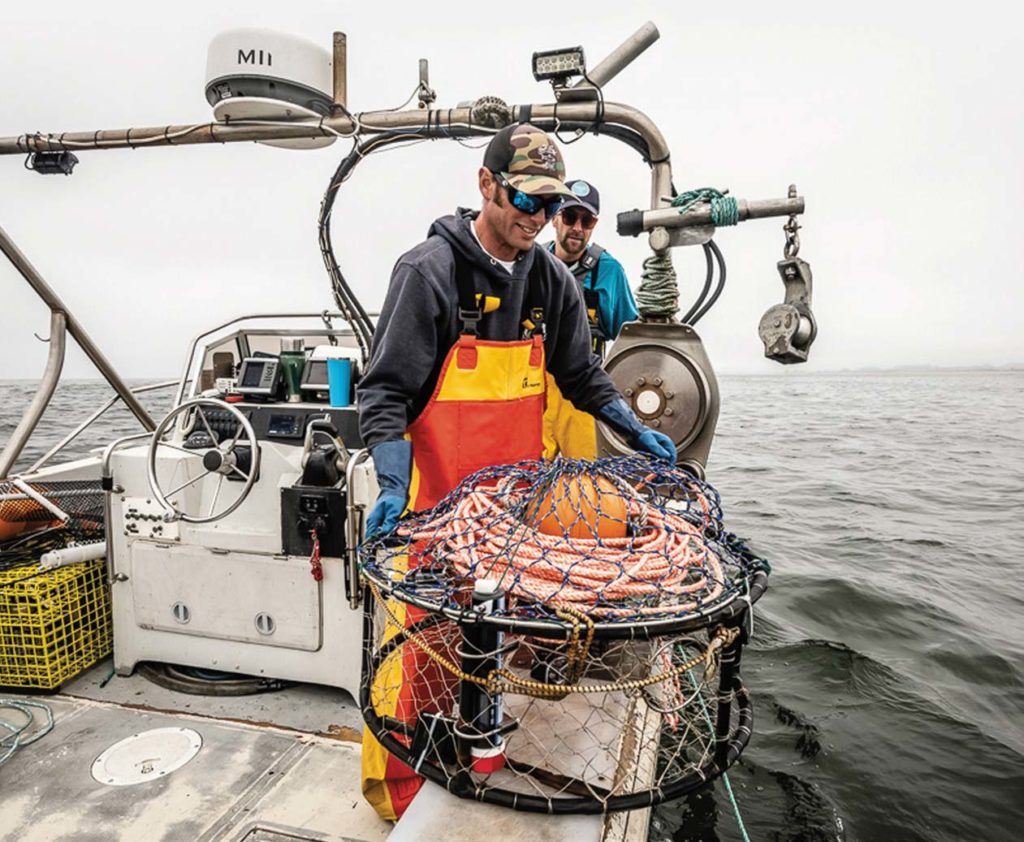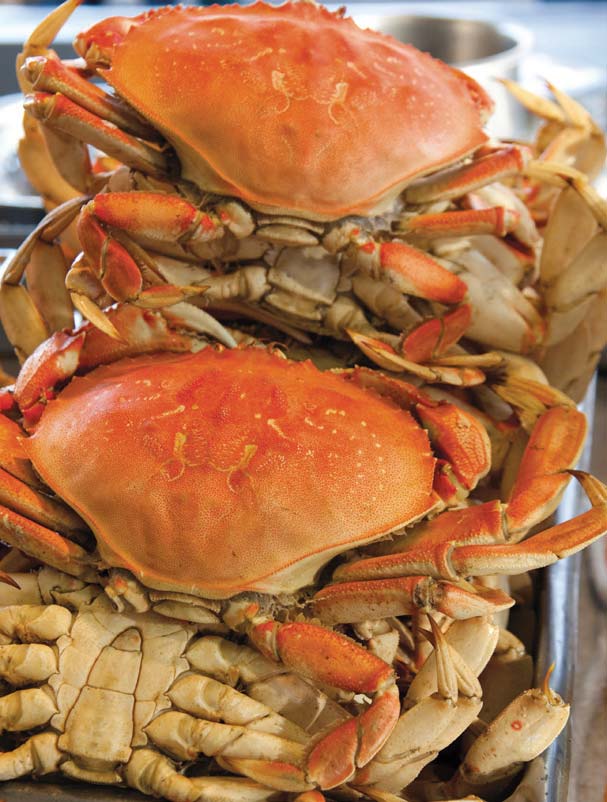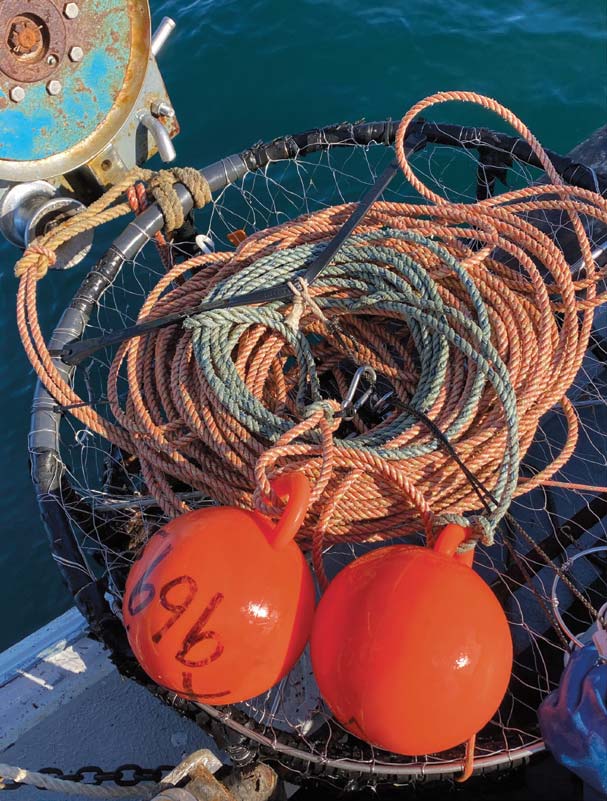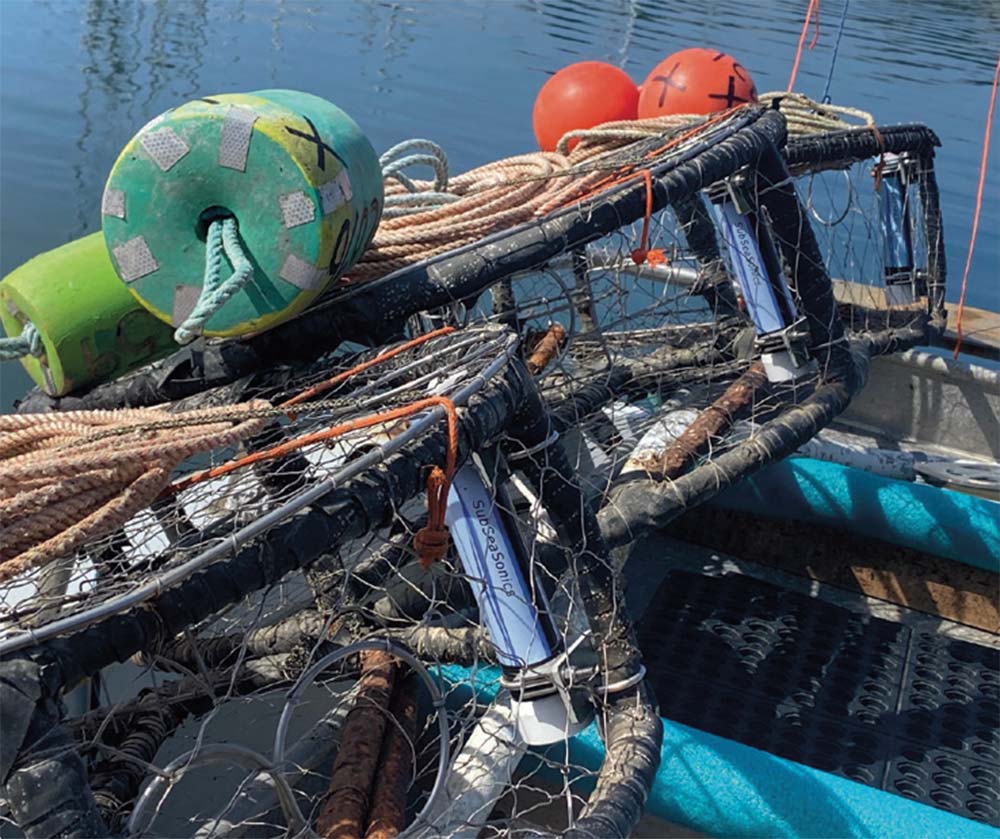PHOTOGRAPHY BY DAVID HILLS

Fracas over pop-up crab traps dangles Dungeness season in the balance
For many foodies, there are few simple pleasures that rival fresh local Dungeness crab. Now that simple pleasure has become increasingly complicated to bring to the table.
It has gotten so tangled, in fact, that one fishery expert—as he surveys a maw of threats, lawsuits, unprecedented environmental shifts and interesting new crab trap technology—calls the current uproar around crab fishing the most controversial oceans story he’s ever encountered.
The biggest reason for that, in a literal and figurative sense, is humpback whales. In the mid-2010s, warming oceans killed off humpback whales’ preferred menu item in historic numbers—namely, krill—so they swam closer to shore in pursuit of alternative prey like anchovies. When they ventured toward land, they encountered ropes that connect crab fishermen’s buoys to crab traps on the ocean floor.
It just so happened there was an atypically large number of traps in the water at that point in 2016 crab season because of another climate- related challenge. Domoic acid was present in the California crab populations that season, so its opening was delayed. When fishermen did get the green light, they were that much more desperate to plop in more pots than they normally would that late in the season.
Along the West Coast in 2016, 71 humpback, blue whale and leatherback turtle entanglements were reported, 22 attributed to crabbers. Californians love them some crab. But they don’t have an appetite for being implicated in whale maiming. Suddenly the situation went from tense to intense.


SCARE TACTICS
On multiple occasions sources for this story referenced being intimidated, scared and even worried about “getting shot” for their role in seeking a solution to California’s crab gear challenges. And it isn’t limited to one side. People take their livelihoods and their whales seriously.
But amid the fear there is hope. Geoff Shester leads the parade on that front. He works with conservationist outfit Oceana as its senior scientist, and he’s very enthusiastic about how innovative new crab trap designs will make it possible to keep fishing the crustacean when whales are present, rather than shutting down crab fishing completely, as has happened the past few years.
“There’s a shared goal of having continued fisheries and safe whale populations off our coast,” he says. “Closures have been hard on fishermen and their families. Gear innovation provides new options for those who choose to use it.”
He adds that the pace of innovation is brisk, with upwards of a dozen companies working on versions of “pop-up” traps that don’t require a vertical line in the water column.
Neptune Marine Products, for instance, does a galvanic timed release with a corrosive metal design that degrades and frees the trap to rise to the surface after a predictable interval. Sub Sea Sonics has introduced what’s called an acoustic release that works via electrolytic erosion. Desert Star Systems designed a broadcast “flip-a-switch” release with virtual gear marking that identifies where the crab pot is, using a smartphone app.
They just need the people who would use it to test it out. As Shester says, “We want to build it up working with local fishermen.” And that’s the catch to this particular catch: Most fishermen refuse to try it.
“They just want to chop us down. They’re saying we’re murderers and we’re not doing our job right and not having a conversation.”
MAKING PROGRESS?
When environmental factors fomented the spike in marine creature entanglements, the Center for Biological Diversity (CBD) sued the California Department of Fish and Wildlife for allowing endangered species to be harmed on its watch (or more accurately, with its permits). At the time, the state had already formed the California Dungeness Crab Fishing Gear Working Group, composed of commercial and recreational fishermen, environmental organization reps, members of the whale entanglement response network, and state and federal agencies. That group, in turn, launched a Risk Assessment and Mitigation Program to aggressively identify and prevent run-ins with gear.
The Center for Biological Diversity was happy to give the working group added motivation, but felt it was far from enough to sufficiently protect whales. In the subsequent years its representatives 1) ditched the group because they were convinced the voluntary measures on which it was based wouldn’t work; 2) co-sponsored the Whale Entanglement Prevention Act (aka AB 534), which would have mandated the conversion of California’s trap fisheries to ropeless gear by the end of 2025; and 3) petitioned the National Marine Fisheries Service after AB 534 was pulled when author Rob Bonta was appointed California’s attorney general.
If the petition is successful, it will mandate all ropeless traps in a lot of places. They would be required in marine sanctuaries within three years and in select state waters within five.
That has fishermen, already an excitable sub-population, steamed. For the vast majority of them their message is plain: no way they’re switching to the new technology.
The simple success of the working group in addressing things like excess lines presents one big reason fishermen don’t want to switch (though there are other reasons).
Longtime fisherman Dick Ogg, 69, sits on the group, representing Bodega Bay.
“We’ve minimized interaction,” he says. “We’re on the right track, we’re doing the right things and those things are working really well. We’ve already solved the issue. How is this fair?”
Ryan Bartley leads the working group and is a scientist with the Department of Fish and Wildlife. He verifies the progress, noting a total of two whale entanglements attributed to crabbers in 2020 and 2021.
“There’s a combination of factors at play—risk assessment, the cooperation of the fleet, best fishing practices and improved ocean conditions,” he says, “but we are trending way down.”
Fishermen also point to the cost of new pop-up traps and the expensive and time-consuming challenges of retrieving gear that doesn’t function properly. “We’ve minimized our interaction but [they] still want us to go to a situation where it’s not practical for us to make a living,” Ogg says.
Along with his fellow fishermen, he bristles at being demonized by the Center for Biological Diversity, whose messaging has lacked climate change context and cast fishermen as bad actors, he says.
“We’re being looked at as people trying to destroy the ocean when we’re the conservationists and that’s our living,” he says. “Why would we damage it? We’re very conscious of what we’re doing. We’re trying to make things better, and we’ve truly done a good job.”

TESTING STANDOFF
Prunedale’s David Toriumi fishes out of Santa Cruz and also serves on the working group, representing Monterey Bay. He’s even conducted tests of ropeless gear in hopes of saving more of a shrinking crab season. That alienates some fishermen who flinch at the attempt to have the gear forced on them, and Toriumi reports feeling scared of vigilante retribution when he enters various ports. But he reserves his biggest frustration for the CBD and its decision to stop engaging with the working group.
“It’s frustrating because they don’t crab, they’re not on the boat,” he says. “They haven’t come out to talk to us fishermen and see our struggles. They just want to chop us down. They’re saying we’re murderers and we’re not doing our job right and not having a conversation.”
He wishes CBD would focus more on container boat collisions with whales. “It’s mind boggling they’re picking on small guys when big corporations are literally mowing over whales,” he says. But the good news is they are; the Center for Biological Diversity filed a legal petition with the Biden Administration requesting speed limits for vessels off California, to accomplish precisely that.
CBD senior attorney Kristen Monsell sounds well-acquainted with pushback from fishermen. “We recognize change is hard and people don’t like it,” she says, “but that doesn’t mean change shouldn’t happen.”
She believes requiring ropeless traps by law is the path forward.
“Ropeless fishing is the only way to eliminate entanglement while allowing fishing to continue,” she says. “That future isn’t going to be realized unless that is mandated. The rules on the books aren’t cutting it. We need to do more to save all these amazing critters.”
That leads to a final plot twist that, in turn, leads to a place of hope. Back before the CBD introduced the Whale Entanglement Prevention Act to mandate ropeless compliance in California, crab fishermen were voluntarily participating in at least three different ropeless technology testing projects along the state’s coast. When the idea of nonoptional acquiescence was introduced, many of them promptly backed out—if they weren’t getting a say in their sentence, they weren’t participating in the trial.
Oceana’s Shester gets that. “I don’t think it’s productive to mandate something we don’t know will work,” he says. “It has made the collaboration more difficult.”
Kim Sawicki does too. Through the company Sustainable Seas Technology, she works with fishermen around the world—ropeless traps are also seeing deployment on the East Coast, in Australia and in Canada—to develop gear without long ropes and with constant collaboration.
“I work with these fishermen day in and day out, and they’re a big part of the process in providing tips and tweaks so we can adapt different devices to the way they fish,” she says. “To make something mandatory when we’re trying to get fishermen interested and involved is counterproductive.”
A funny thing happens when they do try out the gear, she adds.
“When fishermen start getting their hands on the gear, they come up with better ways to use it,” she says. “As soon as they start playing around with it, their negative attitudes, reluctance and fear go away.” Fishermen, Shester, Sawicki and the Center for Biological Diversity do agree on something: Government, nonprofit funders, market factors and trap innovators are all relevant to making new crab technologies affordable.
They just disagree on how to get there, and aren’t currently dialoguing on how to do it.
Hopefully, in coming months, more collaboration—and a longer crab season—are on the menu.
About the author
Mark C. Anderson, EMB's managing editor and "Found Treasures" columnist, welcomes responsible and irresponsible feedback. Correspond via mark@ediblemontereybay.com.
- Mark C. Andersonhttps://www.ediblemontereybay.com/author/markcanderson/
- Mark C. Andersonhttps://www.ediblemontereybay.com/author/markcanderson/
- Mark C. Andersonhttps://www.ediblemontereybay.com/author/markcanderson/
- Mark C. Andersonhttps://www.ediblemontereybay.com/author/markcanderson/



